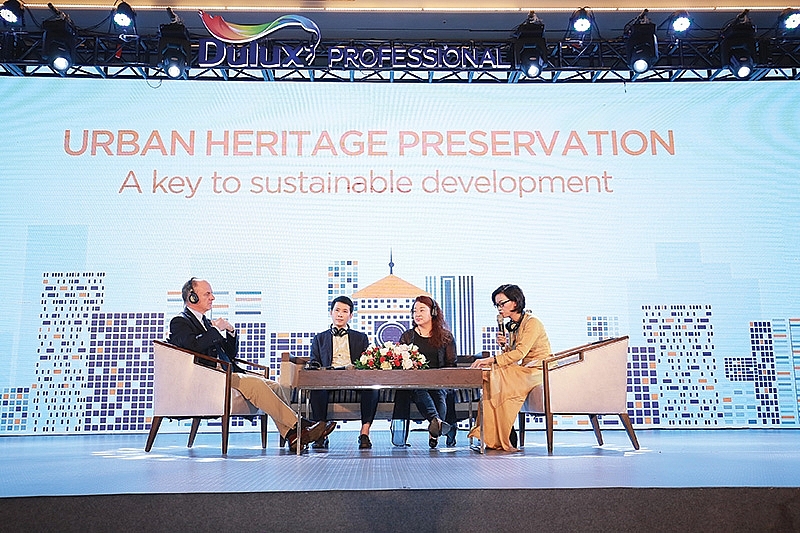Repair or renew: heritage preservation
 |
| The seminar in Hanoi saw experts discuss their views on how to preserve key cultural sites in a globalised world whilst maintaining cultural identity |
The event also featured the insights of Luigi Croce, chairman of the Venice Architects Association, the city with probably the richest experience in heritage preservation.
“Understanding our past brings us great opportunities to grow as a business. We cannot grow without understanding and appreciating our past. At AkzoNobel we believe that we can play a key role in addressing these challenges through our innovations and products,” said Pamela Phua, general director of AkzoNobel Paints Vietnam, in her opening speech.
She went on to point out that cultural sites are a key to maintaining the nation’s cultural identity in a globalising world and will be a key linkage to connect with future generations. At the same time, the nation’s culture will also play a key role in achieving sustainable development which is fully inclusive.
National heritage sites, if properly restored, could also be turned into revenue generators through Vietnam’s already blossoming tourism industry.
“If you can restore the important, iconic buildings and landmarks to their previous glory, I assure you, a lot of people will come to visit. There must be an icon, an important landmark for a city that can also be the pride of the nation,” she said.
AkzoNobel has found a true calling in preserving cultural monuments and historically-important buildings – and is in a unique position to do so. Since 2016, when the heritage preservation programme took shape, the company has created more than 70 products and services under the Dulux Professional brand for projects in Vietnam, bringing improved resources, energy efficiency, longer durability, and even higher safety to users. These solutions have been successfully applied in the restoration of iconic landmarks around the globe such as Rijksmuseum and Van Gogh Museum (the Netherlands), Burkill Hall (Singapore), and Malacca (Malaysia). While in Vietnam AkzoNobel gave a fresh, restored face to the Ho Chi Minh City Museum of Fine Arts and Dai Lanh Lighthouse, the 100-year-old symbol of the central province of Phu Yen.
The March 21 seminar was aimed at revitalising nationwide heritage preservation efforts by mobilising private-sector stakeholders to take part as well as by bringing an important theoretical conundrum to the attention of the more than 200 participating developers and professionals.
Croce, bringing visual examples from his long experience of renovations and restorations across the globe, posed the question: how far can restoration go before it turns into transformation? Can we fully return a building to its former glory – “make a ‘new’ old building” – without losing the patina accumulated through centuries, and can we replace what was broken?
Croce argued that there is no rule of thumb applicable as each work of art such as a fresco, a statue, a building, or even a complex of buildings erected through centuries, is a unique accumulation of art, talent, and history.
The two schools of thought, one adhering to simple restoration with little space for interpretation, the other taking a broader view of a work of art’s history or meaning, all within the tricky subject of relevance to current and future times, need to be applied on a case-by-case basis.
At times, missing details need to be recreated and gaps filled in, other times the restorer needs to appreciate how missing details add to the value of the art. Indeed, Croce gave an example of a fresco in which he refused to fill in the eroded parts, but several other works of art come to mind like the Venus de Milo, where half the romance comes from the guesswork of what the missing arms could have looked like.
Finally, Croce regaled the audience on the finer points of Italian law governing the restoration and protection of heritage sites, warning the audience that a work of art can be far more than a building or an object. It can encompass vast empty spaces, such as parks or squares, along with the surrounding areas of heritage objects that need to be preserved to lend the full effect to the artefacts.
The seminar was AkzoNobel’s latest effort to preserve important heritages through its extensive Dulux Professional portfolio and follows up the Smart City – Sustainable City Seminar held last year in Hanoi and Ho Chi Minh City, and the Sustainable Real Estate Development Conference. AkzoNobel was also the sponsor for the Association of Vietnamese Architects at the Singapore Green Building Week. Dulux Professional also sponsors a series of events on urban heritage preservation held by SCE Project Asia and IUAV.
“Heritage preservation is AkzoNobel’s way of connecting with the community, the people, and the country,” Phua emphasised.
| Nguyen Huy Khanh - Deputy general director Vietnam National Construction Consultants Corporation JSC
To avoid controversy in deciding what needs to be preserved and what can be let go, we need a clear legal framework. At present, written guidelines for the people responsible, such as owners, regulators, or project designers, are few and far between. It is not even clear what needs to be preserved. Currently, the urbanisation process is growing strongly, therefore, conservation works, in addition to bringing historical and cultural values, can also produce business benefits. For example, buildings located in a central, convenient location can profit investors. It is difficult to assess the difference between conservation and reconstruction. Not all heritage buildings can be conserved due to time and money constraints. In order to catch up with market trends, investors often choose to dismantle old projects and build new ones. This is a contradiction between development and conservation. I personally think that this is natural, and we need to issue detailed rules as soon as possible to avoid regrets if a valuable project is not preserved in the correct way. The exploitation of cultural and heritage items is a smart idea, and the project will become a very good marketing tool for the owner. Whether the exploitation is effective largely depends on the consultancy firm helping with the design and co-ordinating with the investor to balance the cost and benefits of the conservation project. This requires a dialogue between the parties, bringing benefits to investors, authorities, and the community. Nguyen Quoc Thong - Vice chairman, Vietnam Association of Architects
Heritages are a valuable cultural symbol, therefore, carelessly destroying a heritage is like losing an invaluable asset. Speaking of the commercial side, heritages are a wonderful added value as they enrich our material and spiritual life. However, heritages also need to adapt to modern life. In a clever way, we need to preserve heritages without losing their cultural value while keeping them relevant to the ways of life. This requires talent and co-operation among many parties. Some works can be replaced, but cannot be renewed or can be repaired but not turned into other things. In some cases, we can use new materials to replace old things while keeping the sense of the past. In addition, a building is always connected to its surroundings, so when preserving a building, we cannot forget the space around it. We should mobilise capital to serve this conservation, but pay attention to balancing the interests of the parties, including investors, authorities, and communities. A conservation project needs the government’s permission, business investment, and the community’s support. Nguyen Hoang Phuong - Conservation architect
|
What the stars mean:
★ Poor ★ ★ Promising ★★★ Good ★★★★ Very good ★★★★★ Exceptional
Related Contents
Latest News
More News
- Heavy industries set for pilot greenhouse gas quotas (December 25, 2025 | 10:00)
- Swedfund invests in MSME growth and climate action in Vietnam (December 19, 2025 | 11:42)
- GreenYellow brings solar energy to light up remote schools in Tuyen Quang province (December 19, 2025 | 08:00)
- Charge+, Grab partner to develop EV charging network in Vietnam (December 18, 2025 | 17:11)
- Linking sci-tech and innovation to Vietnam’s net-zero future (December 18, 2025 | 14:31)
- Driving double-digit growth through green and circular transformation in Vietnam (December 17, 2025 | 09:00)
- Standard Chartered and ACCA deepen collaboration to develop Vietnam’s talent for a sustainable future (December 15, 2025 | 18:18)
- Schaeffler reports strong early output from Dong Nai solar project (December 12, 2025 | 15:16)
- Forestry conference highlights biodiversity and sustainability goals (December 09, 2025 | 13:35)
- Home Credit honoured among top 10 sustainable companies in trade and services (December 09, 2025 | 12:18)




 Tag:
Tag:





















 Mobile Version
Mobile Version